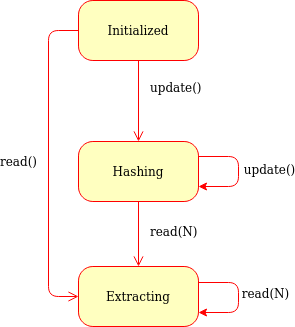TurboSHAKE128 and TurboSHAKE256¶
TurboSHAKE is a family of eXtendable-Output Functions (XOFs) based on the Keccak permutation, which is also the basis for SHA-3.
A XOF is a generalization of a cryptographic hash. The output digest of a XOF can take any length, as required by the caller, unlike SHA-256 (for instance) that always produces exactly 32 bytes. The output bits of a XOF do not depend on the output length, which means that the output length does not even need to be known (or declared) when the XOF is created.
Therefore, a XOF object has a read(N: int) method (much like a file object)
instead of a digest() method. read() can be called any number of times,
and it will return different bytes each time.

Generic state diagram for a XOF object¶
The TurboSHAKE family is not standardized. However, an RFC is being written. It comprises of two members:
Name |
(2nd) Pre-image strength |
Collision strength |
|---|---|---|
TurboSHAKE128 |
128 bits (output >= 16 bytes) |
256 bits (output >= 32 bytes) |
TurboSHAKE256 |
256 bits (output >= 32 bytes) |
512 bits (output >= 64 bytes) |
In addition to hashing, TurboSHAKE allows for domain separation
via a domain separation byte (that is, the domain parameter to Crypto.Hash.TurboSHAKE128.new()
and to Crypto.Hash.TurboSHAKE256.new()).
Hint
For instance, if you are using TurboSHAKE in two applications, by picking different domain separation bytes you can ensure that they will never end up using the same digest in practice. The important factor is that the strings are different; the actual value of the domain separation byte is irrelevant.
In the following example, we extract 26 bytes (208 bits) from the TurboSHAKE128 XOF:
>>> from Crypto.Hash import TurboSHAKE128
>>>
>>> xof = TurboSHAKE128.new()
>>> xof.update(b'Some data')
>>> print(xof.read(26).hex())
d9dfade4ff8be344749908073916d3abd185ef88f5401024f029
- class Crypto.Hash.TurboSHAKE128.TurboSHAKE(capacity, domain_separation, data)¶
A TurboSHAKE hash object. Do not instantiate directly. Use the
new()function.- read(length)¶
Compute the next piece of XOF output.
- Parameters:
length (integer) – the amount of bytes this method must return
- Returns:
the next piece of XOF output (of the given length)
- Return type:
byte string
- update(data)¶
Continue hashing of a message by consuming the next chunk of data.
- Parameters:
data (byte string/byte array/memoryview) – The next chunk of the message being hashed.
- Crypto.Hash.TurboSHAKE128.new(**kwargs)¶
Create a new TurboSHAKE128 object.
- Parameters:
domain (integer) – Optional - A domain separation byte, between 0x01 and 0x7F. The default value is 0x1F.
data (bytes/bytearray/memoryview) – Optional - The very first chunk of the message to hash. It is equivalent to an early call to
update().
- Return:
A
TurboSHAKEobject
- Crypto.Hash.TurboSHAKE256.new(**kwargs)¶
Create a new TurboSHAKE256 object.
- Parameters:
domain (integer) – Optional - A domain separation byte, between 0x01 and 0x7F. The default value is 0x1F.
data (bytes/bytearray/memoryview) – Optional - The very first chunk of the message to hash. It is equivalent to an early call to
update().
- Return:
A
TurboSHAKEobject